Voice of the People - Volume 16
You lazy lot of bone-shakers -
Songs and dance tunes of seasonal events
Topic TSCD 666
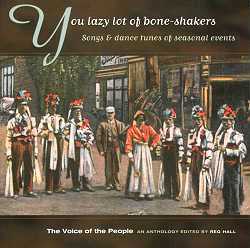 This is the one of the albums in the series that bears direct comparison with a release in Topic's previous great series on British traditional music and song, the Kennedy/Lomax 'Folk Songs of Great Britain'. The subtitles of the two volumes are very similar 'Songs & dances tunes of seasonal events' and 'A collection of songs related to seasonal ceremonies' and there is even some crossover in the content;
both contain Phil Tanner's Gower Wassail, the Helston dance and Padstow recordings though in truth the proportion of instrumentals to songs (17 to 9) is much higher in the current series.
This is the one of the albums in the series that bears direct comparison with a release in Topic's previous great series on British traditional music and song, the Kennedy/Lomax 'Folk Songs of Great Britain'. The subtitles of the two volumes are very similar 'Songs & dances tunes of seasonal events' and 'A collection of songs related to seasonal ceremonies' and there is even some crossover in the content;
both contain Phil Tanner's Gower Wassail, the Helston dance and Padstow recordings though in truth the proportion of instrumentals to songs (17 to 9) is much higher in the current series.
What's it all about then, this ceremony business? Here the notes on the two series differ considerably. The earlier volume has phrases like "ceremonial custom of magical intent" which used "the sacred power of song" only to deteriorate with the years from their original ritual importance to "exchanging sacredness for entertainment, others degenerated into horseplay and nonsense". Unsurprisingly, the VOTP notes do not go in for such claims, the strongest being that "many annual customs ... point to archaic and unfathomable roots in early European culture." 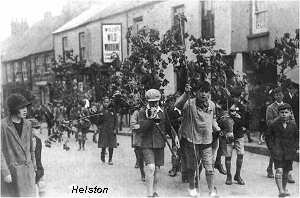 Why did it continue? Well, for one thing, there was some money in it. "The practice of a custom has almost always brought some financial reward to its participants in the form of patronage or a collection, and there seems little doubt that in earlier times the chance of a few extra pence for beer money was a strong motivating force behind the practice for many of them." Reg is also clear that "the Edwardian theories of morris dancing, linked-sword dancing, hobby horse ceremonies and mummers' plays being fertility rituals has now been largely discredited."
Why did it continue? Well, for one thing, there was some money in it. "The practice of a custom has almost always brought some financial reward to its participants in the form of patronage or a collection, and there seems little doubt that in earlier times the chance of a few extra pence for beer money was a strong motivating force behind the practice for many of them." Reg is also clear that "the Edwardian theories of morris dancing, linked-sword dancing, hobby horse ceremonies and mummers' plays being fertility rituals has now been largely discredited."
I feel that the really significant statement that Reg makes about the music and song of ceremonies is that " ... the onlookers are not expected to be passive; they have their part to play." The music and song presented here is enormously involving whilst sitting listening to it at home; being there experiencing them happening can be quite over-powering. Was it the overwhelming feelings associated with these ceremonies that has these led so many early academics/collectors to ascribe quasi-religious origins to them?
One particularly exhilarating aspect here is the power and vitality of the drumming. 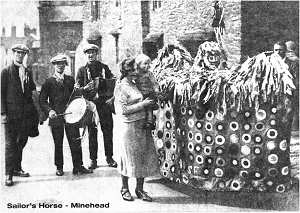 One of the more notable innovations to the Lewes Bonfire parades in the last four or five years has been the highly body-painted New Age drum bands. Arguments have raged in the town about the validity of these bands, but a purely emotional response without intellectualising the reasons for their presence would be that they fit perfectly with the feel of the event.
One of the more notable innovations to the Lewes Bonfire parades in the last four or five years has been the highly body-painted New Age drum bands. Arguments have raged in the town about the validity of these bands, but a purely emotional response without intellectualising the reasons for their presence would be that they fit perfectly with the feel of the event.  The sound of much of the drumming here particularly that of the Padstow Merrymakers (sound clip) and the Minehead Sailor's Hobby Horse gives me the same feeling.
The sound of much of the drumming here particularly that of the Padstow Merrymakers (sound clip) and the Minehead Sailor's Hobby Horse gives me the same feeling.
 Only two of the 26 items on this album come from outside England. One is the justly famous Phil Tanner and the other is that of the Listowel Wrenboys (sound clip).
Only two of the 26 items on this album come from outside England. One is the justly famous Phil Tanner and the other is that of the Listowel Wrenboys (sound clip). 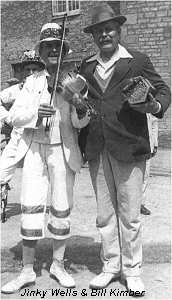 Many Irish folk will tell you that the playing for the Wrenboys is the only place that you should hear the bodhran!
Many Irish folk will tell you that the playing for the Wrenboys is the only place that you should hear the bodhran!
 The morris is well represented with tracks that range from the clipped precise anglo-concertina playing of Bill Kimber (sound clip - Double Set Back) to the wild and weird sounds of Jinky Wells combining his fiddling and humming with Bampton Morris. There's also the unique fiddling of Stephen Baldwin and the Abingdon Morris
The morris is well represented with tracks that range from the clipped precise anglo-concertina playing of Bill Kimber (sound clip - Double Set Back) to the wild and weird sounds of Jinky Wells combining his fiddling and humming with Bampton Morris. There's also the unique fiddling of Stephen Baldwin and the Abingdon Morris  dancing to mouth-organ. Moving north, there's two examples of the Britannia Coconut Dancers Band and their lovely measured playing. (sound clip - Garland Dance No 3)
dancing to mouth-organ. Moving north, there's two examples of the Britannia Coconut Dancers Band and their lovely measured playing. (sound clip - Garland Dance No 3)
Another instrumental was the unexpected item from the Scan Tester double album,  with Scan playing one of the many melodies that carry the words of Whilst Shepherds Watched their Flocks (sound clip). This one is generally called Lyngham. It is an apparently very simple rendition of a melody, but the extremely careful placement of the accompanying chords towards the end of a held note with occasional addition of two resolving chords on notes next to one another at the end of a line of melody make it a thing of great distinction and beauty. To find a comparison with the effect that Scan is producing here, one would have to turn to the recordings of the masters of the uillean pipes and the way they would use the regulators. Most recordings of Scan are of him playing dance tunes or quite fast songs for people to join in with. I feel to hear him playing a slow melody shows his style more effectively. It also reminds me of the quiet, unobtrusive way that he would join in with unaccompanied singing in pub or folk club, after giving the singer a verse or two to establish themselves.
with Scan playing one of the many melodies that carry the words of Whilst Shepherds Watched their Flocks (sound clip). This one is generally called Lyngham. It is an apparently very simple rendition of a melody, but the extremely careful placement of the accompanying chords towards the end of a held note with occasional addition of two resolving chords on notes next to one another at the end of a line of melody make it a thing of great distinction and beauty. To find a comparison with the effect that Scan is producing here, one would have to turn to the recordings of the masters of the uillean pipes and the way they would use the regulators. Most recordings of Scan are of him playing dance tunes or quite fast songs for people to join in with. I feel to hear him playing a slow melody shows his style more effectively. It also reminds me of the quiet, unobtrusive way that he would join in with unaccompanied singing in pub or folk club, after giving the singer a verse or two to establish themselves. 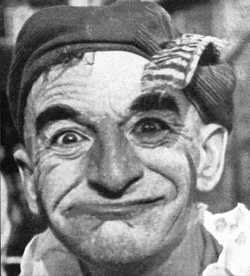 Scan is playing in the key of C and he once self-deprecatingly told me that he always played in that key. How come he could always find whatever key an unaccompanied singer started off in?
Scan is playing in the key of C and he once self-deprecatingly told me that he always played in that key. How come he could always find whatever key an unaccompanied singer started off in?
Turning now to the songs, but remaining with the vigilant nocturnal protectors of Ovis, George Dunn contributes nicely different words and a tune that soars agreeably towards the end of each verse. The solo album of George's singing has long been unavailable. This reminds us that the treasure trove that is the Leader archives, whilst not as extensive as that of Topic, does contain many jewels, which the public are currently denied access to. Emma Vickers demonstrates one of her numerous involvements in traditional music and song with the fine singing of the well-known walking-on song for the Burscough Pace Eggers and elsewhere its the songs associated with Mummers and Wassailers. Two are from North Walsham in Hampshire, Frank Bond offers God Bless the Master of this House, the song associated with the play, whilst his brother Sam gives us something of post-mumming merrymaking with an enquiry into St. Nicholas' summer whereabouts. There are wassailers from Gloucestershire and from Bodmin,  but it is two from 1936 that stand out in these categories, the wonderful BBC archive recording of the Dorchester mummers and the diamond that glitters in this crown as it would in any other; Phil Tanner's Gower Wassail (sound clip). Reg Hall's notes on customs reflect the current thinking on playing down any mystical association, but in a metaphorical sense, Phil Tanner is pure magic.
but it is two from 1936 that stand out in these categories, the wonderful BBC archive recording of the Dorchester mummers and the diamond that glitters in this crown as it would in any other; Phil Tanner's Gower Wassail (sound clip). Reg Hall's notes on customs reflect the current thinking on playing down any mystical association, but in a metaphorical sense, Phil Tanner is pure magic.
Vic Smith - 2.12.98
Site designed and maintained by Updated: 20.8.02
 This is the one of the albums in the series that bears direct comparison with a release in Topic's previous great series on British traditional music and song, the Kennedy/Lomax 'Folk Songs of Great Britain'. The subtitles of the two volumes are very similar 'Songs & dances tunes of seasonal events' and 'A collection of songs related to seasonal ceremonies' and there is even some crossover in the content;
both contain Phil Tanner's Gower Wassail, the Helston dance and Padstow recordings though in truth the proportion of instrumentals to songs (17 to 9) is much higher in the current series.
This is the one of the albums in the series that bears direct comparison with a release in Topic's previous great series on British traditional music and song, the Kennedy/Lomax 'Folk Songs of Great Britain'. The subtitles of the two volumes are very similar 'Songs & dances tunes of seasonal events' and 'A collection of songs related to seasonal ceremonies' and there is even some crossover in the content;
both contain Phil Tanner's Gower Wassail, the Helston dance and Padstow recordings though in truth the proportion of instrumentals to songs (17 to 9) is much higher in the current series.
 Why did it continue? Well, for one thing, there was some money in it. "The practice of a custom has almost always brought some financial reward to its participants in the form of patronage or a collection, and there seems little doubt that in earlier times the chance of a few extra pence for beer money was a strong motivating force behind the practice for many of them." Reg is also clear that "the Edwardian theories of morris dancing, linked-sword dancing, hobby horse ceremonies and mummers' plays being fertility rituals has now been largely discredited."
Why did it continue? Well, for one thing, there was some money in it. "The practice of a custom has almost always brought some financial reward to its participants in the form of patronage or a collection, and there seems little doubt that in earlier times the chance of a few extra pence for beer money was a strong motivating force behind the practice for many of them." Reg is also clear that "the Edwardian theories of morris dancing, linked-sword dancing, hobby horse ceremonies and mummers' plays being fertility rituals has now been largely discredited."
 One of the more notable innovations to the Lewes Bonfire parades in the last four or five years has been the highly body-painted New Age drum bands. Arguments have raged in the town about the validity of these bands, but a purely emotional response without intellectualising the reasons for their presence would be that they fit perfectly with the feel of the event.
One of the more notable innovations to the Lewes Bonfire parades in the last four or five years has been the highly body-painted New Age drum bands. Arguments have raged in the town about the validity of these bands, but a purely emotional response without intellectualising the reasons for their presence would be that they fit perfectly with the feel of the event.  Many Irish folk will tell you that the playing for the Wrenboys is the only place that you should hear the bodhran!
Many Irish folk will tell you that the playing for the Wrenboys is the only place that you should hear the bodhran!
 Scan is playing in the key of C and he once self-deprecatingly told me that he always played in that key. How come he could always find whatever key an unaccompanied singer started off in?
Scan is playing in the key of C and he once self-deprecatingly told me that he always played in that key. How come he could always find whatever key an unaccompanied singer started off in?